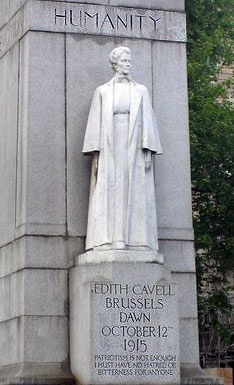Edith Cavell

Edith Cavell was born in 1865 in England. She was the daughter of an Anglican pastor. She studied first in Brussels then in Switzerland, and finally in Dresdes and Aix-la-Chapelle where she learnt German techniques in medicine and hygiene. Returning to England in 1895, she worked first as a governess, before obtaining her nursing qualification at the 'London Hospital' before returning in 1906 to work at the Institute of Surgery and directing the Berkendael medical institute in Brussels. In 1914, the Red Cross built a hospital in her establishment, which rapidly became a refuge for French, Belgian and English soldiers wishing to rejoin the front by passing through the Netherlands. Miss Cavell thus became an important link in this ?escape network? from the north of France to Holland via Belgium.
Her group's activity intensified with the retreat towards the Marne of the French and English forces. Wounded soldiers remained stranded in the field hospitals of Northern France and the Ardennes, whilst others lost contact with their units. The soldiers who managed to avoid attracting the attention of the German forces were taken care of by princess Marie de Croÿ at the château de Bellignies, before being taken to Edith Cavell from whom they received clothing and forged documents before rejoining their armies. This continued from November 1914 to July 1915, enabling two hundred people to escape the German occupied zone.
Eventually the ring was denounced and the sixty-six members of the underground network were arrested during the summer of 1915. The French spy Gaston Quien was accused of denouncing the network, but he was acquitted due to lack of evidence. Edith Cavell was arrested on the 15th of July, attempting to smuggle allied prisoners over the Dutch border, and she was incarcerated in Saint-Gilles prison. During her interrogation, she did not deny the facts: "I considered it my duty to do this for my country", she said; an attitude which would lead to her being accused of being a traitor and held responsible for the collapse of the Belgian intelligence service. Edith Cavell was imprisoned in solitary confinement. The German authorities pretended to yield to diplomatic pressure and allowed the lawyer Sadie Kirsten to defend her, however they did not allow him to speak to her or consult her case notes. The court hearing for the spying ring took place on the 7th September to the 8th October 1915, under the authority of general Ströbel. The case was highly publicised and was designed to serve as an example. The death penalty for conspiring with the enemy was therefore called for. On the 11th October 1915, Edith Cavell, the countess Jeanne de Belleville and Louise Thuliez, a schoolteacher, were condemned to death. The American legation secretary attempted to obtain a pardon for Edith Cavell, but his efforts were in vain. The sentence was carried out on the 12th October 1915, at seven O'clock in the morning.
Her co-conspirators were sentenced to forced labour for life. This execution provoked a storm of protest in England and the United States, just after the Lusitania had been torpedoed. Anti-German propaganda begun to circulate and volunteers started to sign up. After the war, on the 7th May 1919, the remains of Edith Cavell were repatriated to England. A ceremony was held in Westminster abbey. A column was erected in Trafalgar Square (London), near to the National Gallery in memory of this trans-national heroine. A bas-relief, destroyed in 1940, was also dedicated to her in the Museum of Jeu de Paume (Paris).

Statue à la mémoire d'Edith Cavell. Source : http://en.wikipedia.org

